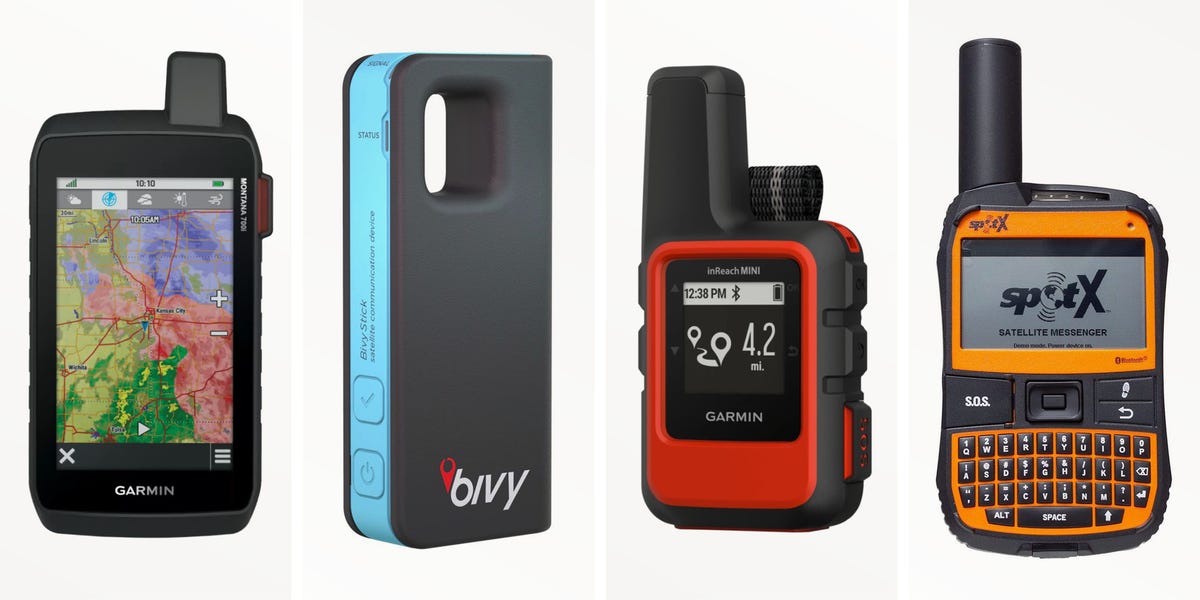
Call it a satellite communicator or a satellite messenger. Either way, you don’t want to go off the grid without one. In emergency situations, these handheld devices let you call for help, but most of the time they’re a conduit for texting with family or friends when cell service is spotty at best. Some even have navigation features to help you find your way. Garmin and Spot are the biggest names on the market, but since 2018, new competitors have joined the fray with more affordable options designed to work with your phone.
Read quick reviews of four standout options, then keep scrolling for buying advice and in-depth reviews of these and other models.
- nadutech logo
- nadutech icon
Iridium vs. Globalstar: Which Satellite Network is Best?
If you can see the sky, you can usually send a message with a satellite communicator. That’s because these devices transmit radio waves up to satellites in Low Earth Orbit to send texts. They also work with separate GPS satellites (based in Medium Earth Orbit, thousands of miles farther away from the surface) to pinpoint and track your location.
There are a handful of private satellite communication networks in the outdoor recreation market, but the two big players are Iridium and Globalstar. Iridium started commercial service in 1998 and recently replaced its aging orbiting infrastructure with the help of Space X’s Falcon 9 rockets. The company promises global coverage through 66 satellites and a few spares that are 476 miles from Earth. Globalstar, which owns Spot, began in 2007 and offers coverage in 120 countries, including those in the Americas, Europe, Australia, and much of Africa and Asia. Either network is fine for most adventurers, but if you’re planning a trip to the poles, in central Africa, or parts of the Middle East, choose Iridium’s broader coverage.
[editoriallinks id=’dfb66edb-a78f-4a33-bb2d-97ab38904917′ align=’left’][/editoriallinks]
Remember, the clearer the path to the sky, the better your connection will be. For the best service, avoid sending texts from tight canyons, dense forests, or in cloudy conditions. It’s also a good idea to make sure your message was delivered before throwing your communicator in your pack, as the fabric or other gear can also interrupt transmission.
Know Your Messaging Preferences
Selecting your preferred messaging capabilities can help you choose the right satellite communicator for you. A majority of models offer two-way messaging so you can receive texts from loved ones or emergency responders, but Spot offers devices with outgoing capabilities only. The option to send custom or preset messages (programmed before you leave home) via SMS or email is also fairly standard, but some gadgets only allow for one or the other.
You also have a choice between a standalone device or one that integrates with your phone via Bluetooth. Standalone units almost always have a screen for mapping purposes and have either a qwerty or touchscreen keyboard for messaging. These extras come with a price penalty, but it’s a fair tradeoff if you want to save weight by ditching your phone. Then again, if you’re photographing your adventures with your phone for some epic latergrams anyway, choosing an integrated device will let you save some dough.
Other Considerations
All satellite messengers have GPS location tracking in case of emergency or so your contacts back home can keep an eye on your progress. A few devices stop there, but many provide offline maps, downloadable waypoints, or other features commonly found in handheld GPS units. If you already use and are committed to a GPS app or prefer paper maps, skipping out on real-time navigation is another way to save money.
[poll id=’1df7a897-4a93-4e98-b45b-d1df08d9ea63_25beb0ac1d684′ type=’text’ question=’How important is it to have navigation capabilities in a satellite communicator?’ answer1=’Very. Give me that map.’ answer2=’Eh, I just need the tracking.’][/poll]
As with any gear with a battery and that you’ll be hauling on your back, bike, or boat, don’t forget to factor in battery life and weight. And remember, just like your cell phone, your satellite communicator requires a data plan to send and receive messages and track your location. Most companies offer annual and month-to-month subscriptions, which are more cost-effective for people who only take a few trips each year. There are often activation fees to start (or resume) service, and you can also get dinged with overage charges unless you’ve selected an unlimited plan. It’s a good idea to review a specific company’s policy before purchasing.
[image id=’3cbeea2e-abd8-4aca-a914-0eac603b01f5′ mediaId=’540c82da-9697-4350-939a-430d242ef5b8′ align=’center’ size=’medium’ share=’false’ caption=” expand=” crop=’original’][/image]
How We Tested
To find the best satellite communicators, we started with a list of 12 gadgets and considered the features, price, weight, and battery life of each. Those that we were able to test accompanied us on backpacking trips and other excursions. While using them, we paid attention to their user-friendliness and reliability. For models we haven’t gotten in our hands yet, we consulted reviews from customers and expert sites, including OutdoorGearLab, Gear Patrol, Backpacker, Adventure Alan, and Outside. Read on to find out about the seven messengers we recommend.
—HIGHLY RATED—
Garmin inReach Mini
Weight: 3.5 oz. | Battery Life: 35 hours to 24 days | Real-Time Navigation: Yes | Standalone Device: Yes
[product contentProductId=’a1579acd-2332-44ed-adea-2b7877d5dba4′ mediaId=’9caaf4bf-0d34-4758-a923-3895d7693386′ align=’center’ size=’medium’][/product]
When the inReach Mini launched in 2018, it drew some attention. It was cheaper, smaller, and lighter than previous devices in the inReach family, and it’s still earning its spot at the top of many reviewers’ lists. The pint-size package is appealing to the ultralight crowd, but it punches above its weight in terms of features. From the device, you can exchange preset and custom texts, send an SOS, get weather reports, receive basic navigation info, and track your location in intervals as short as two minutes (the most detailed reporting available from any company). Pair it with your phone through Garmin’s Earthmate app and you have even greater functionality: namely, the ability to download offline maps; check your mileage, vert and other stats; and use a touchscreen keyboard instead of the very slow scrolling version on the Mini. What’s more, conservative usage extends the battery life for week-long adventures or more ambitious thru-hikes. Aside from the digital keyboard, the biggest shortcoming is that Garmin’s most affordable service plan limits you to 10 custom messages (including any received texts) and doesn’t cover tracking. Checking, sending, or logging your location costs 10 cents per transaction on the basic service plan, so consider upgrading if you anticipate heavy usage.
—BEST VALUE—
Spot X
Weight: 7.0 oz. | Battery Life: Up to 240 hours | Real-Time Navigation: Yes | Standalone Device: Yes
[product contentProductId=’b651be4e-bef6-4478-8b93-3b2dc62738d7′ mediaId=’317ca2aa-e65e-42d0-8000-80c6942b2c2c’ align=’center’ size=’medium’][/product]
Spot’s X meets the definition of a value pick by balancing affordability with a fairly robust feature set. Its screen is larger than the inReach Mini, and it has a full qwerty keyboard—two things that aid user-friendliness (and add weight). The large battery can last a lengthy 240 hours when using 10-minute interval tracking, according to Spot. Although it’s fairly basic, the X does have built-in navigation. Create waypoints by dropping pins from the unit or by entering GPS coordinates on the Spot Mapping website and syncing your device. In the field, use the built-in compass to help navigate to your chosen destination. You won’t see an actual map, nor will you find one in the Spot X app, which has the same capabilities as the device. The app’s purpose, then, is to act as a different interface, not a supplement. Where Spot does offer more is in its optional S.O.V. service plan, $3 per month or $30 annually, for non-emergency vehicle snafus. You can spend less on a sat comm device, but the X’s combination of two-way messaging, tracking, and navigation features earn it our best buy.
—BEST FOR MESSAGING—
Zoleo Satellite Communicator
Weight: 5.3 oz. | Battery Life: 200 hours | Real-Time Navigation: No | Standalone Device: No
[product contentProductId=’2e0aaba0-4fa3-479e-9d88-1ff6033d896b’ mediaId=’3de67968-50bd-4f80-ab6f-0b9f78ae9bbb’ align=’center’ size=’large’][/product]
A contender for the best value, the new Zoleo doesn’t offer navigation or location tracking at programmed intervals. Though you can choose to send your coordinates in texts, and they’re automatically shared with the rescue team when you use the SOS button. That won’t be a dealbreaker for the explorers who just use satellite communicators to, you know, communicate. And there, it shines. The physical hardware has check-in and SOS buttons, so you could use it in the field as a one-way standalone device. But if you want to carry on a conversation, bring your phone and connect to the compatible app. There you can send and respond to emails and texts, and because you’ll get a dedicated SMS number and email address, contacts can reach you without any barriers (That’s counter to the many models that require you to send a message to someone before they can communicate with you at all). The character limits on traditional texts and emails—160 and 240, respectively—are similar to competitors, unless the recipient is also using the Zoleo app, which increases it to 950 per message. When you’re in cellular or Wi-Fi range, the device defaults to sending texts and emails over these networks, so you can save your credits for when you really need them. Every incoming and outgoing message and weather report counts to your limit on the two lower-tier service plans that start at a pricey $20 per month.
—PAY AS YOU GO—
Bivy Stick Blue
Weight: 3.4 oz. | Battery Life: 120 hours | Real-Time Navigation: Yes | Standalone Device: No
[product contentProductId=’1eabf576-f7ed-42fd-a602-f0c0b214d32b’ mediaId=’21a816d3-323b-49d9-b3ca-e0a2a6628f22′ align=’center’ size=’medium’][/product]
Bivy is the no-annual-contract service provider of the sat comms world. Instead you pay for 20, 100, or unlimited credits, each good for one action, such as exchanging messages, sharing your location, getting a weather report, or logging an hour of tracking. For occasional adventurers, this pay-as-you-go model lets you save in the long run. As for the hardware, the new Blue sees major improvements over the first-generation device. We appreciate that Bivy added check-in and SOS buttons and chopped the weight in half by reducing the size of the battery from 5,200 mAh to 1,400 mAh. The Blue should last for weekend trips, but you’ll need to bring a power supply for anything longer. From the app, we could send and receive texts and emails, navigate with the offline maps, manage our waypoints, and scout beta for future trips. It’s a great choice for ultralight explorers or anyone with a fear of commitment.
—ONE-WAY MESSENGER—
Spot Gen4
Weight: 5 oz. | Battery Life: 1,250 messages | Real-Time Navigation: No | Standalone Device: Yes
[product contentProductId=’59fd9186-ab0a-4065-b16a-8be805f97505′ mediaId=’d45ef621-98a5-4ce0-8451-5d1a2182c094′ align=’center’ size=’medium’][/product]
This fall, Spot gave its line ofone-way communicators a facelift in the Gen4. It looks more like an external hard drive than the chunky tactical appearance of its predecessor, but the changes aren’t all cosmetic. The water-resistance increased from IPX7 to IPX8, so the device should survive a dunk in water up to 6.5 feet deep for 30 minutes or less. Without a screen or Bluetooth capability, the Gen4 is fairly basic, but that’s not necessarily a bad thing. Aside from powering it on or off and sending a few pre-programmed messages throughout the day, we mostly forgot we had it on us. Our peaceful nature retreat wasn’t interrupted by group texts or other non-essential communication. And we liked that it has the same vehicle rescue service (for an additional fee) as the X, though we thankfully didn’t have to use it. The Gen4 doesn’t offer any navigation, which wasn’t a deal breaker for our tester who is a regular All Trails user and carries paper maps as a backup. We appreciated the detailed tracking (the shortest interval is 2.5 minutes), though it wasn’t perfectly reliable when the device was dangling from our tester’spack. The Gen4 also has a motion-activated track setting so the device won’t eat up data (or battery) when you stop for lunch or other breaks. And you should make it through plenty of trips before needing to swap the four long-lasting AAA batteries for a fresh set. Finally, the very affordable price tag makes the Gen4 a great deal if you’re willing to go without a few features.
—LOW ANNUAL FEE—
Somewear Global Hotspot
Weight: 4 oz. | Battery Life: Up to 240 hours | Real-Time Navigation: Yes | Standalone Device: No
[product contentProductId=’f43296fa-1827-456b-8bd5-82c338f9a268′ mediaId=’1e415c09-6501-421b-9723-dc57d5c42138′ align=’center’ size=’medium’][/product]
Somewear entered the market at the end of 2018 with its Global Hotspot and a shockingly low base service plan. The $100 annual fee shaves $45 or more off similar plans from competitors, though you’re limited to 10 messages and 75 pin drops each month. Still, it’s an attractive option for infrequent users who can stomach the initial price tag, which feels steep for a satellite communicator that’s as reliant on a phone as the Hotspot is. All messaging, mapping, and weather reporting happens in the app. Without it, you’re limited to initiating or stopping tracking (by hitting the power button three times) and sending an SOS, which we were glad to see in the event of an emergency if our phone was dead. Of course, the major advantage of this design is how easy it was to use. The app was very intuitive and allowed us to send texts through cellular and Wi-Fi networks when we were in range. The tracking was accurate even under tree cover, but we were disappointed that there’s no option to share mapping links to social media. Thanks to the petite size and secure bungee, the Hotspot was more comfortable to carry on a shoulder strap than larger models that often dangle from a carabiner. We also appreciated the long battery life, though it far exceeded our phone’s.
—BEST NAVIGATION—
Garmin Montana 700i
Weight: 14.5 oz. | Battery Life: 18 to 300 hours | Real-Time Navigation: Yes | Standalone Device: Yes
[product contentProductId=’a866fa32-1469-4463-9420-afb8564cbf5c’ mediaId=’511efdce-d64c-4f7c-ac23-71740278c970′ align=’center’ size=’medium’][/product]
Garmin holds nothing back in the redesigned Montana series, announced last month. The 700i has a full-color 5-inch touchscreen that’s 50 percent larger than the previous model and now comes equipped with preloaded road maps, turn-by-turn navigation, and inReach satellite communication tech. These updates transform the Montana from a handheld-only GPS unit to one that’s ready for the road and lets you communicate with emergency personnel or your family wherever you roam. Optional map views include satellite imagery and public land boundaries delineated on the preloaded topographic maps. The 700i has the same service plans as other Garmin satt devices, meaning it’s able to record your location as frequently as every two minutes but tracking isn’t included in the basic option. Still, the standalone unit, which can last nearly two weeks in Expedition mode, is very capable. Use it to check weather forecasts, monitor changing conditions in real-time thanks to the on-board barometer, message other inReach-enabled devices (handy for communicating with parties at basecamp while you go for the summit), connect to your phone or Wi-Fi, and sync with Garmin’s Alpha and Astro trackers for hunting dogs. It’s a hefty device—more than twice as heavy as the next lightest on our list—and some will balk at the price. But if you employ it in your car, adventure rig, and the backcountry, the Montana is worth the investment.







